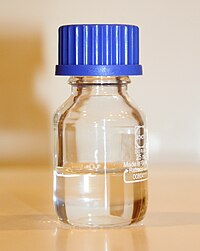
Photo from wikipedia
Abstract Electrocatalytic dehalogenation provides a promising strategy to degrade refractory tribromoacetic acid (TBAA) pollutant into nontoxic acetic acid (AA) and bromide ions. Herein, a novel atomic nickel anchored nitrogenated carbon… Click to show full abstract
Abstract Electrocatalytic dehalogenation provides a promising strategy to degrade refractory tribromoacetic acid (TBAA) pollutant into nontoxic acetic acid (AA) and bromide ions. Herein, a novel atomic nickel anchored nitrogenated carbon (Ni1-N-C) featured of Ni-Ni dual-atom catalysts (DACs) was first reported for the electrochemical debromination of TBAA. At the potential of −0.86 V vs. SCE, nearly 100% of TBAA (10 mg/L) was reduced to AA by Ni1-N-C within 3 h with a high selectivity (88%), surpassing Pd nanoparticles (NPs), Ni NPs and Ag NPs. Moreover, Ni1-N-C exhibited outstanding cycling performance during the long-term test. It is found that TBAA debromination followed a stepwise pathway via a direct mechanism and accorded with a pseudo-first-order kinetics. Density functional theory calculations reveal that Ni-Ni DACs was responsible for the efficient and selective debromination of TBAA to AA owing to the optimized adsorption and desorption for reaction intermediates as compared to Ni single-atom catalysts (Ni-N3 and Ni-N4). This work presents new perspectives to rationally design novel and efficient atomic catalysts for the electrochemical dehalogenation.
Journal Title: Chemical Engineering Journal
Year Published: 2022
Link to full text (if available)
Share on Social Media: Sign Up to like & get
recommendations!